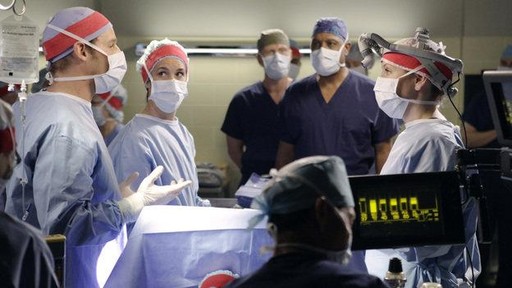
Conjoined Twins
Practice makes perfect.
That's what it takes to successfully separate conjoined babies… Rehearsals and planning and LOTS of practice (Even on television – our actors thoroughly rehearsed the scene where they're "rehearsing" the surgery). Our doctors could not afford to deviate from the plan or timeline. For example, during that tense flip? If Arizona and Richard had slipped up and tangled a wire, they would have risked ruining the sterile field, contaminating an open incision, even detaching an intubation tube.
Yep, that's what I said. Practice.
Conjoined twins develop from the same fertilized egg.
In general, "twinning" occurs in one of two ways. With fraternal twins, a woman releases two separate eggs, which are fertilized by separate sperm. But with identical twins, a woman releases one egg, and it divides into two separate eggs after fertilization. A developing embryo can start to split into identical twins during the first few weeks after conception; however in conjoined twins, the separation stops before the process is complete, and a partially separated egg develops into a conjoined fetus that shares the same amniotic cavity and placenta. Conjoined twins can be diagnosed prenatally via ultrasound. The cause of the remaining connection is unknown, but many researchers suspect environmental factors.
According to the University of Maryland Medical Center, conjoined twins occur once every 200,000 live births.
Approximately 70% of all conjoined twins are girls. Although more male twins conjoin in the womb, females are three times as likely as males to survive. Tragically, approximately 40-60% of conjoined twins arrive stillborn; about 35% survive only one day; and, the overall rate of survival is between 5 and 25%.
Baby Andi and Baby Brandi were "pygopagus" twins, joined at the lower spine and facing in opposite directions. Several types of conjoined twins exist, such as:
- Thoracopagus twins are one of the more common forms – these twins, joined at the upper portion of the torso, share a heart.
- Omphalopagus twins, connected from the breastbone to the waist, may share a liver and gastrointestinal or genitourinary functions.
- Craniopagus twins, a very rare form of conjoined twins, possess cranial fusion.
- Rachipagus twins, joined back to back usually above the lumbar spine, may share extensive vertebrae.
- Ischiopagus twins, fused at the lower abdomen and pelvis, may share a genitourinary system, rectum, and even liver.
Even though more reports of successful separations have surfaced, these surgeries remain extremely complex and risky.
The rate of survival of separating conjoined twins varies on the type of connection and which organs they share. For example, in cases of thoracopagus connections, both twins cannot survive separation because they share one heart. However, when joined at the bottom of the spine (such as Andi and Brandi), these twins face a much better chance at survival since they each have their own vital organs.
Doctors and parents confront overwhelming challenges as they debate the benefits and risks to separation. Some separations could potentially end up sacrificing one twin's life or causing irreversible harm while greatly enhancing the life of the other twin. The parents need to sit down with the surgical team to weigh the ethical implications; they obviously want their children to have as normal a life as possible, but at what cost? They need to become convinced that the present quality of life possesses such a negative outlook that the dangerous surgery should in fact be performed.
If the parents and doctors do decide to proceed with separation, extensive and meticulous planning (usually months worth) will be done before surgery. The team of pediatric specialists will include experts from general surgery, plastic surgery, neurosurgery, neonatalogy, anesthesia, critical care, orthopedics, nursing, social work, and rehabilitation. Complications could entail intracranial bleeding, formation of blood clots in the newly constructed blood vessels, heart complications, and infections.
For more information on conjoined twins, please visit:
http://www.mayoclinic.com/health/conjoined-twins/DS00869/METHOD=print



